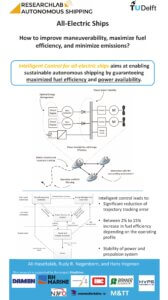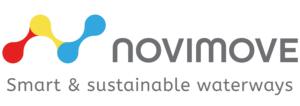Research
Research and test programmes
Thanks to the RAS, a wide range of experiments can be carried out for collecting empirical data for research purposes. The RAS carries out its own tests and research programmes. You can team up with them or carry out your own tests separately.
The RAS is a testing and learning environment for new technologies and the related social opportunities in the areas of sustainable and efficient waterway transport, security, digitisation, economic growth, accessibility, and employment. A wide range of experiments is carried out in the RAS for collecting empirical data for research purposes, as part of a joint research agenda of government and the science and business communities. You can team up with them or carry out your own tests or research programmes separately.
RAS works in a research questions driven way, starting from a specific challenge faced by science, industry or society. With the expertise present within the TUDelft, or within larger (international) consortia, RAS works on addressing these challenges.
RAS Challenges (selection)

|

|

|

|

|

|
Find here more info details regarding these challenges.
Research projects (selection)

|
FAST — Fieldlab Autonomous Shipping TechnologyThe Fieldlab Autonomous Shipping Technology project is realizing an open innovation system in which knowledge institutions, governments, the logistics sector, the tourism sector and technology providers work jointly to innovate and experiment with autonomous sailing and building up knowledge about the application of digital technologies such as artificial intelligence and robotics. The fieldlab focuses on technological, operational, and organizational innovations needed to allow vessels to operate autonomously in various logistics, tourism and mobility applications. RAS carries out technological development focusing on situational awareness, collision avoidance, autonomous decision making and remote operating and the interfaces and communication with the environment. The application in logistics, tourism and mobility involves the development of new concepts and services, new algorithms for planning operations and business cases. Central to the project is the development of an autonomous vessel (a ferry) that will sail in the inner harbor of Vlissingen. Both on the ship and on the quay, it will be possible to follow what the ship sees and which autonomous decisions the ship makes. This allows tourists and residents to gain real-time experience with the possibilities of autonomous sailing. |
|
|
|
|
|
AVATARThe massive under-exploitation of inland waterways (IWW) in the North Sea Region, especially in and around urban environments, provides opportunities for technological innovations. This project aims to deploy zero-emission automated vessels that can do hourly traffic between the Urban Consolidation Centers outside the city and inner city hubs, focusing on the distribution of palletized goods and waste return. The average external cost (congestion, accidents, air pollution, climate, noise, etc.) for inland waterway transport (IWT) accounts for 3.9 €cent/tkm, whereas for road transport this is 70% higher. However, w.r.t urban freight transport (UFT), vessels (< 300T) are currently not economically viable, already resulting in the demolishment of over 12% of small vessels (CEMT I-II) in the last decade. Crew costs for these vessels account for up to 60% of the total shipping costs. Increased automation will be critically important to ensure a sustainable and economically viable future on this scale.
More information: |
|
|
|
|
|
AUTOBargeAccording to the European Commission, passenger transport is projected to increase 42% by 2050, and freight transport up to 60%. Needless to say, this puts an enormous burden on transport networks and our environment. Compared to other modes of transport – which often face congestion and capacity problems – inland waterway transport is characterised by reliability, energy efficiency and a capacity for increased use. More than 37,000 km of waterways connect hundreds of cities and industrial regions in Europe. In the EU, 13 countries share an interconnected waterway network, highlighting the potential for increasing the modal share of inland waterway transport. This will not happen unless we can make inland waterways economically competitive. However, with crew costs accounting for 60% of the total cost, autonomous inland vessels represent an exciting disruptive technology. AUTOBarge is about seizing an opportunity. Europe’s waterways are a vital resource that we have underused for most of the last century. Now, with the possibility for mass autonomous shipping, these canals and rivers offer a network that we can exploit without damaging the environment to the extent of new roads and aircraft runways. But to be able to do this we need new people with new skills. These innovators must be experts in remote control, monitoring, smart logistics, regulatory aspects, and many more areas associated with the complexity of inland shipping. The 15 early-stage researchers recruited to AUTObarge will begin this transport revolution. More information: |
|
|
|
|
|
NOVIMOVESolving inefficiencies on the IWT Rhine-Alpine corridor Inland Waterborne Transport (IWT) advantages as low-energy and low CO2 emitting transport mode are not fully exploited today due to gaps in the logistics system. Inland container vessels pay 6-8 calls at seaport terminals with long waiting times. More time is lost by sub-optimal navigation on rivers and waiting at bridges and locks. In addition, low load factors of containers and vessels impact the logistics systems with unnecessary high numbers of containers being transported and trips being made. NOVIMOVE strategy is to “condense” the logistics system by improving container load factors and by reducing waiting times in seaports, by improved river voyage planning and execution, and by facilitating smooth passages through bridges and locks. NOVIMOVE technology developments will be demonstrated by virtual simulation, scaled model tests and full-scale demonstrations. NOVIMOVE innovations will impact the quantity of freight moved by IWT along the R-A corridor by 30% with respect to 2010 baseline data. The NOVIMOVE 21-members consortium combines logistics operators, ports, system-developers and research organizations from 4 EU member states and two associate countries. More information: |
|
|
|
|
|
NOVIMARThe NOVIMAR project develops a new waterborne transport concept called the Vessel Train. The Vessel Train consists of a fully manned Lead Vessel, followed by a series of lowly manned, digitally connected Follower Vessels. This concept will reduce operational costs and increase economies of scale due to better usage of existing infrastructure. Envisaged reduction of personnel costs will significantly enlarge the economic potential for inland vessels. This in turn will lead to improved access to urban environments for smaller vessels, thereby reducing congestion in populated areas. Additional benefits of the Vessel Train will be obtained by overcoming traditional area-bound limitations of waterborne transport. This will be ensured in the way the NOVIMAR project incorporates sea-river connectivity and elaborates on possibilities for Roll-on/roll-off cargo handling. The NOVIMAR project is unique because it provides technological capabilities for Vessel Train operations together with a sharp focus on economic feasibility and stakeholder alignment, fostering the market potential of the new transport concept. More information: |
|
|
|
|
|
NOMESThe significant reduction of the emissions from port areas, inland waterways, urban areas, and offshore environments cannot be realized without addressing three key challenges. These challenges have not been studied hand in hand and in relation with one another before. NOMES will therefore focus on these following challenges:
In NOMES, the overall objective is to carry out a preliminary study on these 3 key challenges. First, bottlenecks in enabling the solutions in each of the three project challenges will be pinpointed. An investigation on the feasibility of the potential approaches for addressing these bottlenecks is then planned to be carried out. Then, a study on the advantages of enabling novel and minimized emissions shipping is planned. More information: |
|
|
|
TRiLOGyTRiLOGy aims to demonstrate the potential of autonomous and electric vessels for increasing the safety, efficiency and sustainability of transportation and logistics in urban waterways. In order to reach this goal, a joint investigation is needed on fleet management and autonomous sailing. Strategic and operational level optimization models will be developed that optimize various decisions such as fleet sizing, fleet mix as well as routing and scheduling of the vessels to meet the demand in an efficient way. A special challenge lies in the explicit representation of the stochasticity in the demand and network conditions, the adaptive nature with real-time decisions as well as the integration of behavioral models that represent the modal shift towards water. Fleet management should provide the optimized routes to the autonomy side so that data-driven navigation methods generate a safe and detailed trajectory planning. Two case studies are considered: city logistics for construction material transportation and mobility on demand with water-taxis. The proposed methodologies will be tested for the two case studies through realistic simulations and real-life experiments. More information: |
|



